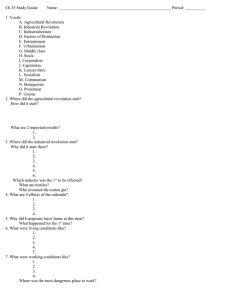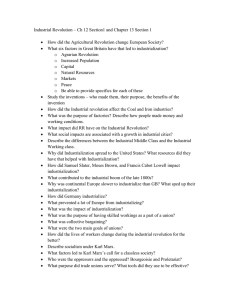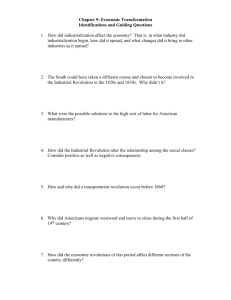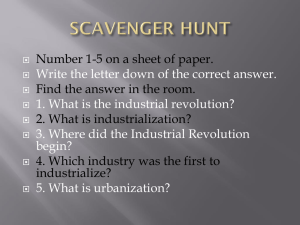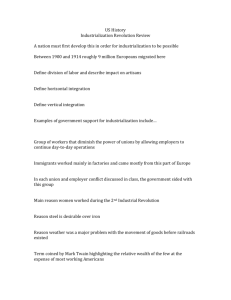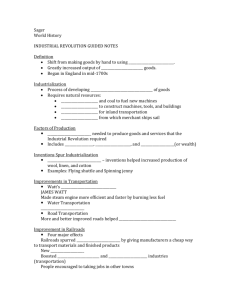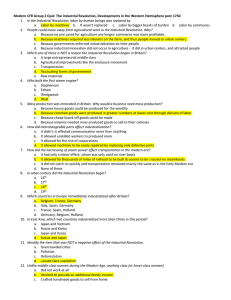Ch. 17 Outline
advertisement
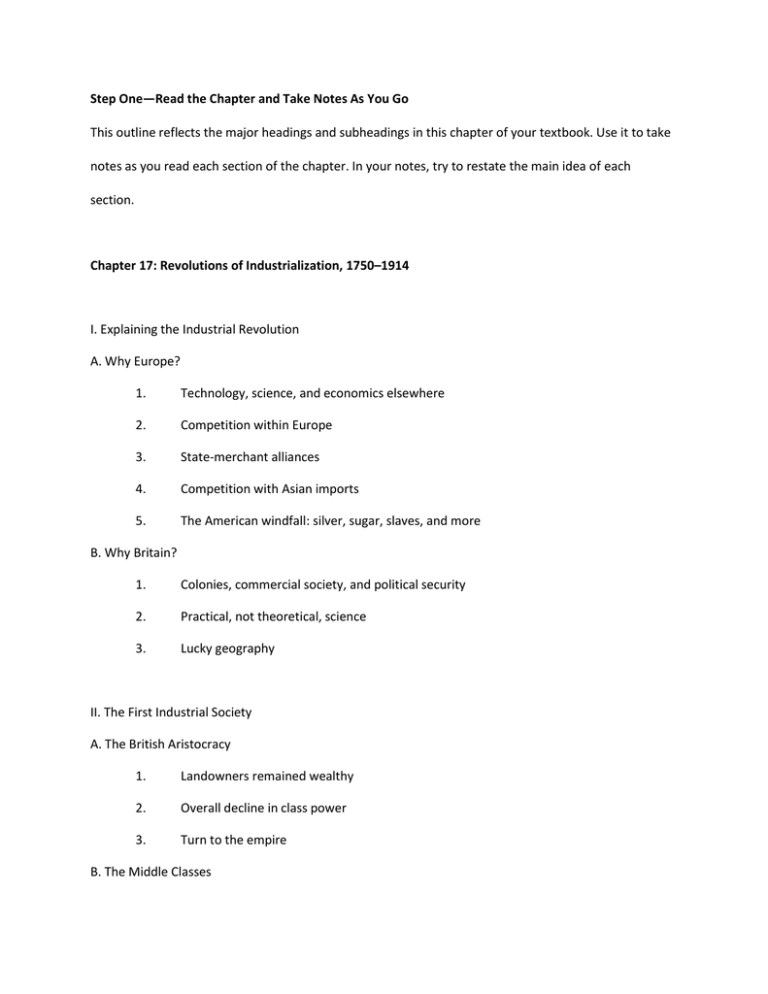
Step One—Read the Chapter and Take Notes As You Go This outline reflects the major headings and subheadings in this chapter of your textbook. Use it to take notes as you read each section of the chapter. In your notes, try to restate the main idea of each section. Chapter 17: Revolutions of Industrialization, 1750–1914 I. Explaining the Industrial Revolution A. Why Europe? 1. Technology, science, and economics elsewhere 2. Competition within Europe 3. State-merchant alliances 4. Competition with Asian imports 5. The American windfall: silver, sugar, slaves, and more B. Why Britain? 1. Colonies, commercial society, and political security 2. Practical, not theoretical, science 3. Lucky geography II. The First Industrial Society A. The British Aristocracy 1. Landowners remained wealthy 2. Overall decline in class power 3. Turn to the empire B. The Middle Classes 1. An amorphous group 2. Classical Liberalism 3. Samuel Smiles, Self-Help 4. Women: paragons of “respectability” 5. The lower middle class C. The Laboring Classes 1. 70 percent of Britain 2. Rapid urbanization 3. New working conditions 4. Women and girls in the factory? D. Social Protest 1. Trade unions, 1824 2. Robert Owen (1771–1858) 3. Karl Marx’s (1818–1883) “scientific socialism” 4. Labor Party and 1910–1913 strikes 5. British reform (and nationalism), not revolution 6. Competition and decline E. Europeans in Motion 1. Migration to cities and other continents 2. Settler colonies 3. “White” Europeans in Latin America 4. Opportunities and diversity in the United States 5. Russians and Ukrainians to Siberia III. Variations on a Theme: Industrialization in the United States and Russia A. The United States: Industrialization without Socialism 1. Explosive growth 2. Pro-business legislation 3. Mass production for a mass market 4. Ford, Carnegie, and Rockefeller as cultural heroes 5. Difficult working and living conditions 6. Strikes and class conflict but weak political organization 7. Conservative unions, racial politics, and high standards of living 8. Populists and Progressives but few Socialists B. Russia: Industrialization and Revolution 1. A complete opposite of the United States of America 2. State-sponsored change 3. Rapid industrialization produces social conflicts 4. Small but very radical proletariat 5. Russian Social-Democratic Labor Party 6. 1905: Revolution, repression, and reluctant reforms 7. Growth of revolutionary parties 8. 1917: Lenin and the Bolsheviks IV. The Industrial Revolution and Latin America in the Nineteenth Century A. After Independence in Latin America 1. Turbulent international and domestic politics 2. Caudillos 3. Caste War of Yucatán (1847–1901) B. Facing the World Economy 1. Steam ships and telegrams 2. Exports to the industrializing world 3. Imported industrial goods 4. Foreign capital investment C. Becoming like Europe? 1. A Eurocentric elite 2. Urbanization 3. Solicitation of European immigrants 4. Few saw economic benefits from exports 5. Growth of unions and strikes provokes repression 6. Rural poverty 7. Mexican Revolution (1910–1920) 8. “Dependent Development” and “Banana Republics” 9. American intervention V. Reflections: History and Horse Races A. Fascinations with “firsts” B. Being first as being better? C. Unexpectedness of the Industrial Revolution D. Perhaps the spread is more important
